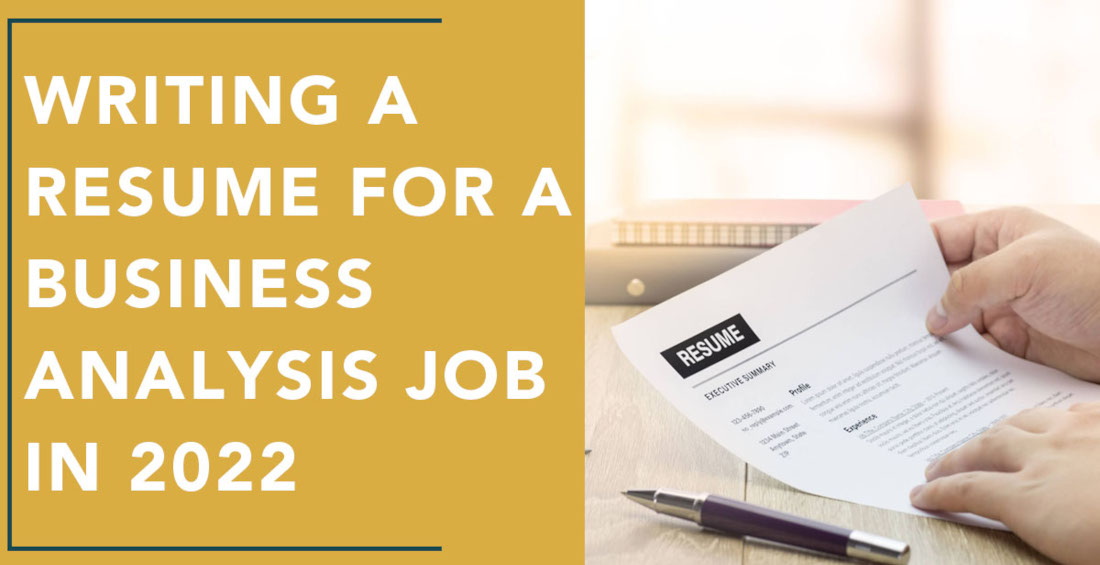Writing a Resume for a Business Analysis job in 2022
January 30, 2022 2022-01-30 21:24Writing a Resume for a Business Analysis job in 2022
As we all know, Resume Writing can be quite a big deal including writing resume for a Business Analysis job. Especially for those who intend to take up new job roles having little or no experience. And as a business analyst, you have a role in a company’s growth. Although, the wide scope of responsibilities makes the job exciting and challenging. There’s no two business analysts that have the same job. So it can be really hard to know what to put on your resume to please hiring managers at different companies. As a business analyst, you’ll need every edge that you can get.
Getting a suitable format and being able to summarize and put all your relevant skills in a well-formatted resume, without feeling less-informative or over-informative can be another issue to consider and stress to deal with. You would need to correctly place the right skills on your resume to get past the automated keyword filters that companies use. Then you gradually progress to the part where you’ll need to convince the hiring manager that you deserve an interview.
Here’s a list of things you’ll learn from this Business Analyst resume guide that help you conquer that feat in writing a good resume.
- How to pick the right combination of technical and soft skills that’s relevant for your role
- How to write bullet points that describe your technical skills and how it’s positive effect on the company.
So rightly, we will delve into how to create these resumes and necessary actions to take. Resumes must be more clean, concise, and convincing than they were in recent years.
How to write a Business Analyst resume: your main points
You have a complex job. Explaining its unique technicalities and the good work you’ve done(for those with experience) will take space. On the other hand, recruiters hate text-heavy and condensed resumes.
Use an ATS friendly format for your Business Analyst resume:
To nail a business analyst role, your resume has to be ATS friendly; ATS is short for Applicant Tracking Software. If you’re not familiar with what ATSs are, don’t worry, we’ll fill you in with the necessary things you need to know.
Applicant Tracking Software or ATS is a relatively new software that helps hiring managers pick suitable fits for a role from hundreds of submissions without even reading the resume. Some companies use ATSs to filter out resumes that do not fit their criteria for hiring. This saves a lot of time for the hiring manager and makes the work easier.
For your resume to be ATS-friendly, you have to use an ATS-friendly resume format. You’re probably wondering what an ATS-friendly resume format looks like. It’s no rocket science, to tailor your resume to an ATS friendly resume format, you have to: remove tables or images and include resume keywords from the job description.
Your job application will have a greater potential of reaching an actual hiring manager if you write your resume with ATS software in mind, increasing your chances of landing an interview.
Click here to see an example of an ATS friendly Business Analyst resume.
Here are some more tips for when your resume has passed the ATS test and is now in the hands of the hiring manager.
Be clear and concise
Your resume should read well, be clear and concise, and have even formatting and fonts. If grammar and syntax are not your strengths (or even if they are), it would be useful to have an editor or proofreader give your writing a second look once you feel the piece is finished. Formatting your resume properly may matter more than you think. For any given BA role a hiring manager reviews 100+ resumes. To that end, they’re looking for a reason to say “no” to any given application they review.
Formatting your resume incorrectly is a quick way to get placed into the “no” pile of resumes. Your goal with formatting your business analyst resume is to make the job of the hiring manager as easy as possible. If you’re a senior business analyst, it would be helpful to keep your education section really short. If you’re an entry level business analyst, include relevant classes you took in school that makes you qualified for the role.
Don’t get too creative with your formatting. Your resume needs to be machine readable so don’t include any images or charts. Although be sure to include links to any relevant work, projects, or write-ups you have in regards to the position. This can be your LinkedIn, Github, personal blog, publications, etc.. Anything that makes the case about your skills as a business analyst. As a senior business analyst, you need to keep your education small to give room to talk about work experience.
Conversely, as an entry level business analyst you need to make the case that you’re qualified to be a BA without much (or any) work experience. To do that, you should include relevant projects you’ve worked on that can demonstrate how skillful you are.
It’s best to use a reverse-chronological or combination resume. A reverse-chronological resume does well in highlighting impressive career trajectories or promotions. If you want to highlight your skills,go with a combination resume format. It organizes your achievements into different skill buckets at the top of your resume.
Show a Range of Skills:
Compared to other tech roles, the scope of hard skills that business analysts need are relatively consistent across companies. Some Business Analysts work in finance, technology, or healthcare. Other business analysts oversee other business analysts to ensure the correct implementation of proposed solutions — this requires management and leadership skills.
Customize your email, job title, and your LinkedIn URL to stand out from the competition. It’s a good way to insert extra keywords in your resume, too. Include any cross-training expertise that you can bring to the table. As companies downsize and learn to do more with less, many business analyst job descriptions, even at larger companies, also include other fields—such as testing or quality analysis; software development; support; or training. If you have experience in any of these fields and would not be averse to helping in those areas, be sure to note it as something that you can bring to the table.
While the business analyst profession is forward-thinking, it is not, as a whole, edgy enough to embrace self-photographs or intricate designs. Think clean, clear, sleek, modern, and professional. Use bullets and white space to keep the resume looking readable and organized. Finally, try not to exceed two pages. Write for machines as well as people. Be aware that the first filter your electronic resume encounters may very well not be human.
The beauty of being a business analyst is that you need work experience to demonstrate the skills needed to succeed in a full-time role! Which is why you should work on part time projects or upskill in a boot camp like Heels & Tech. Fundamentally, a business analyst carries out analysis and research to develop solutions to existing problems, as well as assist in the introduction of these solutions to commercial entities and their customers. Talking about a project you worked on to scratch your own itch demonstrates to a hiring manager that you have the desire and skills to succeed as a business analyst.
You have the recruiter’s attention now. Keep them hooked with an eye-catching resume summary.
Finding the right balance between jargon and layman’s terms.
This is where it gets tricky. In big companies, a recruiter might do a paper-screening to pre-qualify applicants first. But for startups or small businesses, a manager or a Senior Business Analyst will be the one reviewing your application. This may affect your Business Analyst resume. There’s a chance one person reading it may only have a vague understanding of your role. Some recruiters are only given a list of skills or keywords to look for when pre-qualifying applicants. Worse still, they may not even understand the jargon at all.
Remember that a job search and resume creation is a perfect time to put your hard-earned analyst skills into practice. Approach your job search from a practical business analyst’s perspective: determine your goals (the business case), discover what you need to do to get there (the business requirements), and then decide the best path for achieving that (the business solution), which is your tailored resume. Hopefully some of the tips in this piece will help you more reach your ideal business solution—a perfectly polished resume—and the great job that will eventually accompany it more quickly.
Other blog posts: Job opportunities for data analysts, Productivity hacks for business analysis, Women tech founders.





